
It's been an age since I've updated this blog. But a while ago I realized that I was working on so many different projects at the same time, so that nothing was being actually completed!
As a result, I've decided to spend the summer months working on finishing a couple of regiments of Napoleonic French infantry and cavalry that have been looking reproachfully down upon me from the bookcase in a their half-finished state for months now.
On top of that, we've had a few disturbing earthquakes here in Tokyo these past few weeks, a reminder that in this country I've got to get my painted units safely based and into a sturdy cabinet rather than perched precariously on the bookcase shelves as they are at present!
But I have been steadily re-basing the ACW collection at the same time as I have been basing my French, so when the Crapauds are finished and photographed, they will soon be followed by some pictures of my Federals.
In the meantime, here is a YouTube video featuring a Japanese tune dating from the end of WW1- but with an ACW slant!
Marching Through Georgia by Henry Clay Work was popular with the Japanese army during the Russo-Japanese War of 1904-05, and was later made into a popular song here, but with lyrics telling about a country girl visiting Tokyo for the first time.
As a result, I've decided to spend the summer months working on finishing a couple of regiments of Napoleonic French infantry and cavalry that have been looking reproachfully down upon me from the bookcase in a their half-finished state for months now.
On top of that, we've had a few disturbing earthquakes here in Tokyo these past few weeks, a reminder that in this country I've got to get my painted units safely based and into a sturdy cabinet rather than perched precariously on the bookcase shelves as they are at present!
But I have been steadily re-basing the ACW collection at the same time as I have been basing my French, so when the Crapauds are finished and photographed, they will soon be followed by some pictures of my Federals.
In the meantime, here is a YouTube video featuring a Japanese tune dating from the end of WW1- but with an ACW slant!
Marching Through Georgia by Henry Clay Work was popular with the Japanese army during the Russo-Japanese War of 1904-05, and was later made into a popular song here, but with lyrics telling about a country girl visiting Tokyo for the first time.
A great video of a Tokyo now long gone, but some of the landmarks seen in the picture can still be seen today, despite earthquakes, bombs, and years of ceaseless development.



















